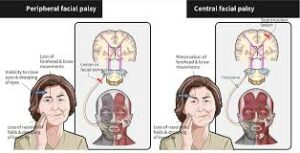Neurofeedback CAN Help.
Bell’s Palsy can come on suddenly, but it usually has been brewing under the surface for some time as the brain ramps up the use of fast electrical energy. This undercurrent of energy can impact your facial nerves and result in Bell’s Palsy. You can heal your brain and face using neurofeedback and get back to living your best life.
I am Dr. Trish Leigh. I have been helping people heal their brains and improve their lives for 25+ years. Also, I know how you feel. I’ve been there. Unfortunately, I suffered from Bell’s Palsy due to Toxic Mold Poisoning. Even before that, I helped many people alleviate their Bell’s Palsy symptoms using cutting-edge Neurofeedback, and my 3×3 Brain Rewire Coaching formula.
What Causes Bell’s Palsy?
Bell’s Palsy is a neurological condition in which the seventh facial nerve is not working properly, causing paralysis of one side of your face. Most people don’t know that Bell’s Palsy is often brought on by stress and overuse of your brain. If you are a high achiever, work a lot, or constantly think, this can contribute to your Bell’s Palsy symptoms. I know, from personal experience, that Bell’s Palsy can be a byproduct of neurotoxin exposure, resulting in Autonomic Nervous System Dysfunction.
Onset tends to be sudden and remarkable. It often creates drooping of one side of your face and difficulty shutting your eye. I preferred to call my experience a “glitchy eye.” It has been associated with stress, is so stressful, and can upset a person’s life dramatically. Rewiring your brain helps the facial nerve to flow freely, and your face will work again.
Pushing Through Can Push You Over the Edge
Pushing through seems logical to many people. In this case, doing so increases the fast speed in your brain, bringing on more problems for you.
Pain, Discomfort, Social Anxiety, and Stress Result
Suffering from these secondary conditions makes the initial cause of Bell’s Palsy worse. You stay stuck and go around and around in circles of anguish.
Neurofeedback helps to calm your brain so it can heal, allowing your symptoms to alleviate.
Neurofeedback is:
- Drug-Free
- Non-Invasive
- No Side-Effects
- Clinically Proven
- Long-lasting Benefits
- Proven successful with a 75-year legacy
Discover How Neurofeedback Can Help
How is Bell’s Palsy Diagnosed?
A special assessment, that includes electroencephalography, qEEG Brain Mapping, has been shown to identify the fast brain mode that can make Bell’s Palsy symptoms worse and stay around longer.
What are the Symptoms?
The symptoms of Bell’s Palsy include:
- Sudden onset of muscle weakness to total paralysis on one side of your face.
- Facial droop, difficulty making facial expressions including a smile.
- Inability or difficulty closing your eye.
- Twitching of your face.
- Pain around your jaw or in or behind your ear on the affected side.
- Decreased hearing on the affected side.
- Decreased taste.
- Decreased production of saliva and/or tears.
Who Gets Bell’s Palsy?
40,000 Americans suffer each year, according to the National Institute of Health. Men and women are affected by Bell’s Palsy equally, and it mostly affects people between the ages of 15 and 60 years old. Stress and lowered immune response can make the condition worse.
Get the Help You Need.
If you want to speed up your recovery from Bell’s Palsy, call Dr. Trish Leigh, who can perform Brain Rewire Assessment. This important information, along with your qEEG brain map and other assessments, will be reviewed as an important part of our comprehensive evaluation. By doing this, we can evaluate your brain function and the functioning of your nerves to determine if you are a strong candidate for Neurofeedback Therapy.
Explore Our Process Now
Facebook
Twitter
Youtube
Podcast
Instagram


